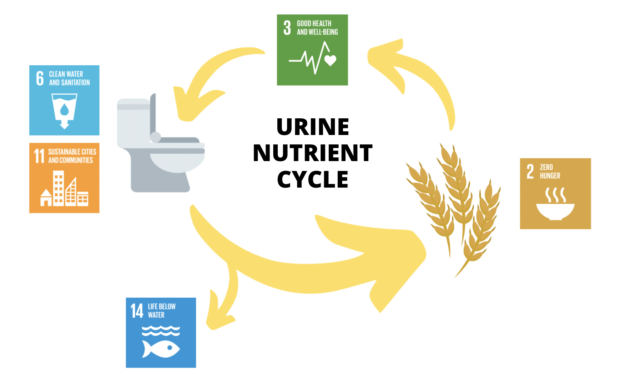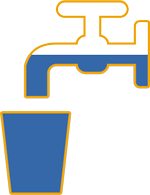Back to all articles
Urine Nutrient Recycling on World Toilet Day

How can urine nutrient recycling support Sustainable Development Goals? On November 19th, World Toilet Day, we think in particular of SDG 6: the goal to achieve Clean Water and Sanitation for all. Around the world, 3.6 billion people lack access to safe and effective toilets.
Toilets not only address a basic human need, but hold the potential to also contribute to clean water, abundant food, and healthy, thriving communities. Good toilets prevent disease and malnutrition, and enable students who mensturate to stay in school. Great toilets can also help address climate change and revitalize local economies.
At Rich Earth’s 2021 Summit, collaborators William Tarpeh and Kory Russell presented a partnership they are developing to improve container based sanitation (CBS), an option for providing sanitation access to communities without wastewater systems, through integrating urine reuse. Their collaboration arose as a result of Rich Earth’s 2020 annual urine reclamation Summit, where they identified the need to translate technical and lab-based research into implementation projects.
CBS is an “end-to-end service that collects waste hygienically from waterless toilets built around sealable, removable containers.” These containers can then be collected regularly and brought to a waste-recovery treatment site. The Container Based Sanitation Alliance (CBSA) is a group of organizations who are providing this service to different communities around the world, and producing a wide range of resources derived from human waste, including compost, biochar, biogas, and black soldier fly feed larvae.
The CBSA serves over 180,000 users around the world. Scaling this work can help to meet multiple sustainable development goals, including addressing the basic need for toilets. And as one recent paper highlights, urine diversion and treatment can expressly address several sustainable development goals. In addition, sustainable sanitation is an underutilized driver to achieving climate resilience. Currently, “sanitation is estimated to be producing approximately 2-6% of global anthropogenic methane which is approximately twenty times more powerful than carbon dioxide at warming the atmosphere” (Reid et al. 2014; Saunois et al., 2016).
CBS is a form of climate- positive sanitation. While CBS produces some greenhouse gas emissions due to the need to transport human waste from communities to treatment centers, it is a significantly better option for the climate due to the ability to utilize the “waste” produced as a resource.
In the past, CBSA members focused primarily on feces management and reuse, but they have started to include urine diversion and utilization as well.
After Rich Earth’s Summit in 2020, Will Tarpeh and Kory Russel combined forces to best support the transition of lab-based research (from the US and Europe) into real-world solutions. These solutions need to be able address the needs and constraints of urine separation in settings without sewers. A main goal for these communities is to reduce the volume of waste for transport while being able to create urine-enriched products such as fertilizer to farms.
How do we scale alternative urban sanitation like CBS? Currently, the largest barrier is financing. People often perceive CBS as an expensive option, but this isn’t true when we take scale and time into account. While sewer based systems have a high up-front cost and low operating costs, CBS is the other way around (low initial investment, and higher costs for system operation.) There is also a false expectation that CBS services should be fully cost recovering. In reality, at scale, CBS is the lowest cost form of safely managed sanitation. This is based on a study conducted by EY (Why it’s time to get behind container-based sanitation) based on in-depth cost information that was gathered from a range of sources.
To help bring CBS to scale, Tarpeh has a vision for a consortium that can leverage perspectives from multiple CBS providers and technology developers to accelerate the impact of urine valorization for container-based sanitation. One objective of such a consortium would be to synthesize specific needs and constraints that CBS programs have for urine treatment options (including through regular surveys and focus groups from CBS partners). This can help urine treatment technology developers to better understand the multi-faceted problems that communities face, in order to help them understand what tools different communities might want. Then, the consortium would rank existing urine treatment technologies and define aspirational targets based on a framework they have developed in partnership with CBS service providers.
Ultimately, this can all help to accelerate the lab-to-field transition. Tarpeh noted that it is “exciting to see at the Summit more and more pilot scale and demonstration scale projects.” One component of this will be to coordinate pilots in many places at once; to better understand how urine valorization can work in different contexts, and understand a range of factors (for example, urine composition can vary but we’re not sure to what extent, there are also other regulations and constraints that vary widely by locale). This will include university implementation for students to use as well as projects with CBS partners. Then together they can build teams for grant proposals as well as guide funding agencies who are thinking about funding urine diversion.
Further Reading
Climate Resilient Urban Sanitation: Accelerating the Convergence of Sanitation and Climate Action – Resilient Cities Network
The potential contribution of urine source separation to the SDG agenda – a review of the progress so far and future development options – Tove A. Larsen, Harald Gruendl, and Christian Binz
Why it’s time to get behind container-based sanitation – EY and Container Based Sanitation Alliance

